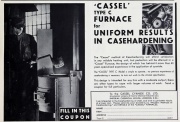Cassel Cyanide Co
of Glasgow (1908)
of Oldbury, Birmingham (1937)
1866 Charles Tennant, grandson of the founder of Charles Tennant and Co, brought together several alkali makers to form the Tharsis Sulphur and Copper Co to take over pyrite mines in southern Spain.
1884 The Tharsis pyrites contained tiny components of gold, so Tennant and his associates formed the Cassel Gold Extracting Co. The company was registered on 15 December to acquire certain patent rights of Mr. H. R. Cassel. Although the Cassel process proved to be useless, the rights to the MacArthur-Forrest process were also subsequently acquired. As a result the level of gold recoverable was increased from 55 per cent to 95 per cent.
1896 Cassel had enjoyed a decade of prosperity but the Transvaal courts then overturned its patents.
1906 The company name was changed to Cassel Cyanide Co[1]
1906 Experiments, on low temperature carbonisation of coal and briquetting of the solid residues, were carried out by George Beilby at the Maryhill Works of Cassel Cyanide Co. Beilby was later creditted as the "creative brain" behind Castner Kellner Co and Cassel Cyanide Co[2].
1927 The growing chemical combine ICI took over Cassel Cyanide Co by exchange of shares[3]. By absorbing Cassel, ICI "cemented more closely" Cassel's long term partnership with the Castner Kellner Alkali Co, as Cassel used large quantities of Castner's products as well as supplying another part of ICI, namely British Dyestuffs Corporation; production would be reorganised to reinforce Cassel's position as the world leading producer of cyanide[4]. Initially it was as a subsidiary of Brunner, Mond & Co.
1929 ICI decided to close Castner Kellner Co's Wallsend works and amalgamate it with the Allhusen Works at Gateshead and the Cassel Cyanide Co of Glasgow; the 3 works were concentrated at Billingham South, called Cassel Works, which became one of the principal factories of ICI's General Chemicals Division[5].
1930 Demonstration of cyanide case hardening at the British Industries Fair at Birmingham[6].
1937 Subsidiary of Imperial Chemical Industries (ICI). Manufacturers of salts and furnaces for case-hardening and heat treatment of mild and alloy steels. "Carbonentral" for Heat Treatment of High Speed Steels. "Cassel" Cyanide for Case-hardening. "Economiser" for Preventing Oxidation of Molten Cyanide Baths. "Rapideep" for Deep Cementation. [7]
1937 Listed Exhibitor - British Industries Fair (Cassel Cyanide). Cassel Salt Bath Processes. Furnaces and Salts for Case-hardening and Heat Treatment of Metals, including Heat Treatment of High Speed Steel and of Cast Iron. (Stand No. D.306)
See Also
Sources of Information
- Biography of Sir Charles Tennant by Richard Davenport Hines, ODNB [1].


